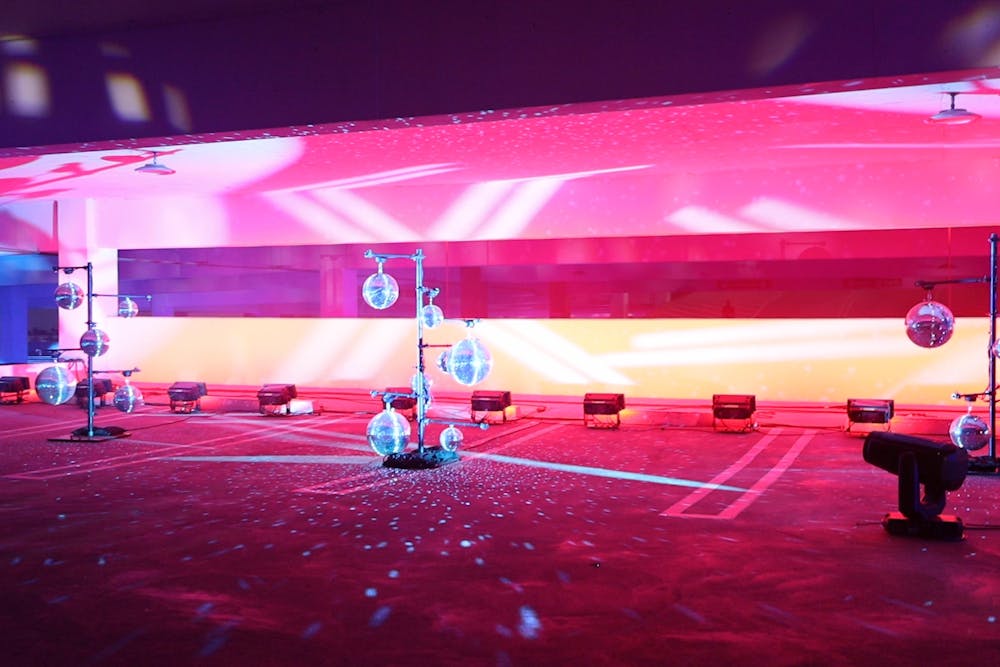Dissolving into stardust and floating among the stars sounds like something out of a fever dream, but becoming a space particle is all part of the immersive experience on the top floors of the Packard Drive Structure.
The event, “designspace: a new drive-thru sensory experience,” leads visitors through a twisting path of ebbing sounds, gleaming lights, disco balls, suspended orbs, curious sea creatures and galactic serenity. The experience, roughly one-mile long created by ASU students and professionals, gives viewers a chance to thrust themselves into the heart of a work of art from the comfort of their cars.
Running April 9 to 25, the installation has drive-thru times available at 7 p.m., 8 p.m. and 9 p.m. Visitors can purchase one ticket for their vehicle and everyone in it for $32.50. The garage is located at 555 S. Packard Drive in Tempe. Cars should enter from Sixth Street off Rural Road, according to the event's website.
The experience is a collaboration between the Herberger Institute for Design and the Arts, ASU Gammage, Video West, Lightswitch and HYBYCOZO exploring the many facets of “space” after society has been distanced for so long due to the pandemic, said Xavier Nokes, a graduate student studying arts, media and engineering who is involved with the project.
Roughly a third of the mile-long experience was designed by students at the Herberger Institute, said Herberger associate dean Jake Pinholster.
ASU students designed six features across the installation that engaged with the concept of space, a variety of other pieces were created by the professional groups. One student group created a section called “Dissonant Waters,” focusing on the lack of humans occupying spaces during the pandemic through the lens of the ocean, said Shomit Barua, a Ph.D. student studying media, arts and sciences.
“My team was interested in thinking a little bit more critically about that (idea of space) and think about spaces that maybe had benefited from our absence, from a decolonization of sorts,” said Olivia Hernández, a graduate student in interdisciplinary digital media in performance who also worked on “Dissonant Waters."
Hernández herself modeled sea creatures using Tilt Brush, a virtual reality painting program. From there, she animated the models using a program called Cinema 4D. Nokes then turned the animations into an interactive experience for vehicles using a depth camera, while Barua and another student worked on developing the sound for the section.
When a vehicle drives up to the feature, virtual layers fall away, revealing a colorful deep-sea scene, complete with angler fish and bubbling aquatic sounds. "Dissonant Waters" is one of the two interactive pieces featured in the event.
Barua also worked on two other features in the installation, “Dancing into Star Stuff” and “Digital Alchemies.” “Digital Alchemies,” found on the first level, surrounds vehicles in lightboards and sound, focusing on creating art out of isolation.
Because the teams of students were working with professional artists and production teams from Video West, Lightswitch and HYBYCOZO, they not only had the opportunity to build relationships with those in the field, but the students also had access to high-quality equipment, allowing them to watch their ideas come to life on a massive scale.
Working on the immersive experience gave students a “chance to learn on equipment that they would never have access to as part of our normal production seasons,” Pinholster said.
Ellen Beckett, director of projects at Lightswitch, said the company wanted to bring a safe and accessible feature to viewers, and the Packard Drive Structure was the perfect place.
The approximately 35 students who collaborated on the event “expanded the idea of what we thought the show could be,” Beckett said.
With the help of high-quality equipment and professional support, the student teams are excited to bring an art piece to visitors for possibly the first time since the beginning of the pandemic.
“I think that there will be a level of escapism that has not been really prominent or available to all of us since we've been stuck inside of our homes for over a year now,” Nokes said.
The teams hope that the installation gets visitors to think about what space really means, in all ways, from the edges of the universe to the depths of the sea.
“I would rather that people walk away and take a moment to reflect on what this last year has meant for all of us,” Barua said. “It's collective grief, you know, collective that there isn't a lot that happens in the world where the entire world is kind of joined together by this one thing.”
Reach the reporter at alcamp12@asu.edu and follow @Anna_Lee_Camp on Twitter.
Like The State Press on Facebook and follow @statepress on Twitter.
Continue supporting student journalism and donate to The State Press today.





